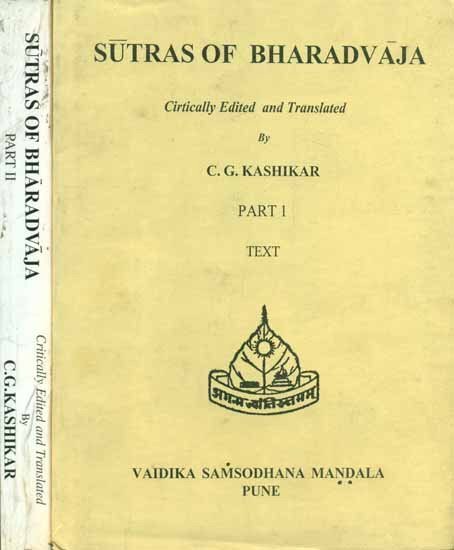Bharadvaja-srauta-sutra
by C. G. Kashikar | 1964 | 166,530 words
The English translation of the Bharadvaja-Srauta-Sutra, representing some of the oldest texts on Hindu rituals and rites of passages, dating to at least the 1st millennium BCE. The term Srautasutra refers to a class of Sanskrit Sutra literature dealing with ceremonies based on the Brahmana divisions of the Veda (Sruti). They include Vedic rituals r...
Praśna 14, Kaṇḍikā 12
1. The officiating priests should put down three portions of Puroḍāśa[1] each on the ground by the side of their respective goblets.
2. The formulas. “This, O father, for thee and for those by thy side...[2], beginning with the one relating to the offering and ending with the one relating to their sending off should be regarded as prescribed in the Piṇḍapitṛyajña.[2]
8. There is a view that they should offer the portions of Puroḍāśa to their own fathers, grandfathers and great grandfathers; there is another view that the sacrificer himself should murmur the formulas, and others should put down the portions without reciting any formula.
4. The Adhvaryu should draw from the Āgrayaṇa vessel the Sāvitra cup into the Antaryāma cup with the Anuvāka, “prosperity today, O Savitṛ, prosperity tomorrow; mayest thou procure prosperity for us day by da Through this prayer may be won the prosperity of many pros perous dwellings, O god. Thou art taken with a support; for god Savitṛ thee.”[3]
5. He should not place the cup.
6. Then he should give out the call (to the Maitrāvaruṇa),“Do you recite the puronuvākyā relating to the offering for god Savitṛ.”
7. After having crossed over, and having caused the Āgnīdhra to announce and (after the latter has responded,) he should say to him, “Do you address a call to the Hotṛ to recite the yājyā relating to the offering for god Savitṛ.”
8. At the vaṣaṭ-utterance he should make the offering. There is no secondary vaṣaṭ-utterance.
9. In that cup which contains drops of Soma, he should draw the cup for Viśve Devas from the Pūtabhṛt with the formula, “Thou art taken with a support; for Viśve Devas thee. Thou art having good happiness, having steady place. Obeisance to the great bull. (He should place it with the formula,) “This is thy birth-place; for Viśve Devas thee.”[4]
10. The Śastra[5] should be recited at this stage.
11. When he knows the Hotṛ reciting the verse, “O Vāyu, thou conveyest the oblations by means of thy own (chariot) furnished with eleven mares or twenty-two mares or thirty-three mares. Do thou unyoke them here,”[6] the Pratiprasthātṛ should cleanse the Dvidevatya cups[7] and place them on the mound.
12. When he knows the Hotṛ reciting the verse, “I worship the great Dyāvāpṛthivī, increasers of the divine order and wise, with oblations at the service, who, having gods for their sons and doing good deeds, together with the gods, grant boons (to worshippers who have approached) with true service,”[8] the Adhvaryu should respond to it up to the vyāhāva with the expression containing the word moda in one part, namely, modā moda iva, othā moda iva.[9]
13. After having responded to the reciting of the Śastra, the Adhvaryu should take up the cup; the Camasādhvaryus should take up the Nārāśaṃsa goblets.
14. After having crossed over, and having caused the Āgnīdhra to announce and (after the latter has responded,) he should say, “O reciter of the Śastra, do you recite the yājyā relating to the offering of Soma.”
15. At the vaṣaṭ-utterance he should make the offering.
16. The shaking of the goblets has already been explained.[10]
17. The Adhvaryu should modify the formula[11] relating to the consuming of the cup as “...(of thee) who art drunk by Savitṛ and Viśve Devas.”
18. The formula relating to the consuming of the Nārāśaṃsa goblets has already[12] been mentioned.
19. The Camasins should consume the goblets completely.
20. They should not make the goblets swell with water. The goblets should be cleansed.
21. Henceforward in the third pressing all goblets should be consumed completely.
Footnotes and references:
[1]:
XIV.11.17.
[2]:
I.8.7-9.13.
[3]:
Taittirīya-saṃhitā I.4.23.
[4]:
Taittirīya-saṃhitā I.4.26.
[5]:
The Vaiśvadevaśastra to be recited by the Hotṛ. cf. ĀśvŚS V.18.2.
[6]:
ĀśvŚS V.18.5. cf. Maitrāyaṇī-saṃhitā IV.6.2; Vājasaneyi-saṃhitā XXVII.33; Atharva-veda VII.4.1; Taittirīya-āraṇyaka I.11.8.
[7]:
XIII.27.16.
[9]:
Āpastamba-śrauta-sūtra XIII.13.8-10 mentions two options: (i) madā moda iva, modā moda iva, (ii) madā moda iva, othā moda iva, modā moda iva.
[10]:
XIII.32.1.
[11]:
XIV.11.18.
[12]:
XIII.27.19.
